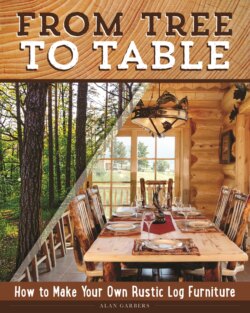Читать книгу From Tree to Table - Alan Garbers - Страница 16
На сайте Литреса книга снята с продажи.
Where to Find the Best Trees
ОглавлениеUnless you live in a house built by Dr. Seuss, your house is built with right angles; walls are straight and the same thickness at the top as they are at the bottom. Dimensional lumber is made to maintain a uniform size and thickness from stud to stud, joist to joist, rafter to rafter. This makes it much easier to build a house that is square and trim. Drywall fits correctly, trim fits correctly, etc.
The problem with logs is that none of them are the same size from top to bottom. Oh, some of them look like it, but despite their looks, the log is smaller on top than it is on the bottom. This makes getting our dimensions right during the build difficult. The top rail of a headboard needs to be slightly longer than the bottom rail, and other little things like that. So, the closer the logs are to milled lumber, or perfectly symmetrical columns, the easier it is for us to use in our projects.
The big question is “Where do we find the straightest logs in the forest?” That’s easy. Go to where the woods are the thickest. Foresters call it Early Successional Growth (ESG). In reality, we want the mid to later stages of ESG. Here’s why: A tree is trying to grab as much sunlight as possible so it can do its thing and grow. If you notice as you drive around the countryside, yard trees with no trees around them are very bushy with lots of branches, but generally no towering main trunks. There might only be one tree per acre. They don’t need to grow tall to find sunlight. To make matters worse, often the trunk is more pyramid shaped than column-shaped.
In a thick part of the woods, the trees are competing for the sunlight. Starting out after a farm field turns fallow, a forest is logged, or a forest fire rages through, there might be 20,000 saplings per acre. In their battle for the sunlight, the trees keep racing upward to beat the other trees for sunlight. In the process, the lower branches stop receiving sunlight and die. Eventually, they rot away or break off. This process often makes trees as straight and columnlike as we are ever going to find in nature. For the most part, those are the trees we want for our furniture.
A fallow field quickly reverts back to forest. I cut dozens of ash saplings from this stand, all straight as an arrow.
TREES TO AVOID
I feel I should caution you about trees you shouldn’t cut.
• Never cut trees that the property owner wants to keep. It’s money out of their pocket if you do.
• Never cut trees that may fall on valuable trees. Loggers are experts on dropping trees in directions away from valuable trees, but unless you’re experienced in the matter, don’t risk it. One wrong cut can cost the property owner thousands of dollars in destroyed timber.
• Beware trees that are holding up a “widow-maker.” The weight of a dead branch or even an entire tree pushing against the tree you want to cut can create a huge hazard. Often, there is no warning that a branch or dead tree is falling until it’s already too late.
• Beware a leaning tree. There are two distinct hazards of cutting a leaning tree:
• If the cut is made from the side it is leaning toward, the weight can cause the tree to lean more, pinching the saw blade. In many cases, another saw has to be used to complete the cut from the opposite side. The extra pressure and a twisting tree can damage a saw blade.
• If the cut is made from the side opposite the direction of lean, as the cut is made, the weight is often too much for the remaining fibers to hold. The tree splits, often without warning. This violently thrusts the loose section of the tree trunk back toward the cutter. This can have unbelievable springlike energy that can impale anyone in the way. Loggers call the remaining tree stump a “barber’s chair.”
• Beware a yard tree. Many yard trees have been the home for tree houses, swings, and who-knows-what. Yard trees are often riddled with buried nails and other bits of metal. All it takes is one nail to ruin a band saw or chain saw blade.
• Beware a fence line tree. Like a yard tree, they can have wire fencing and staples buried in them. But, usually, the tree is clear above the four-foot (1.2 m) line.
• Blistering, rotten, or otherwise damaged trees should be avoided. Sassafras trees rot and blister even as they grow. If you live in the humid areas of the U.S., be wary of any wood on the ground. I would quarantine any suspect wood in a sunny and dry area until it is proven clean. Rotten wood has no place in furniture. The last thing you want is to bring termites into your shop.
